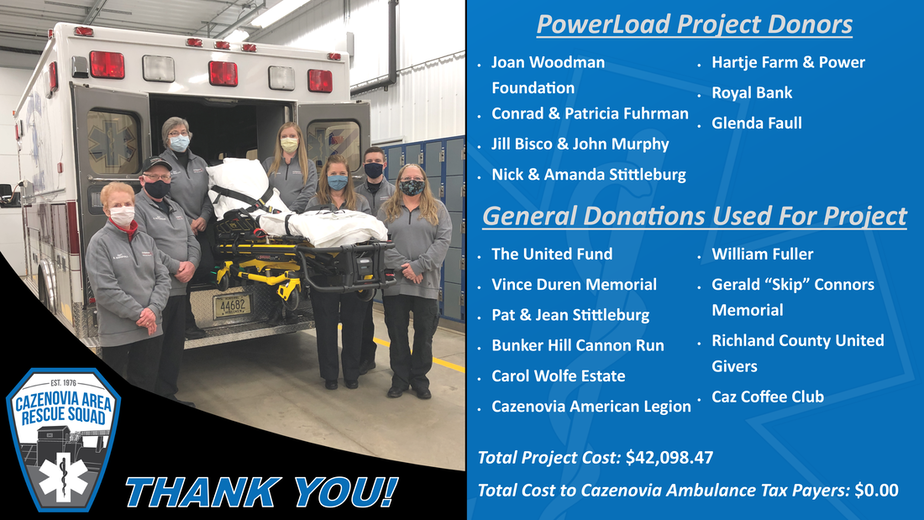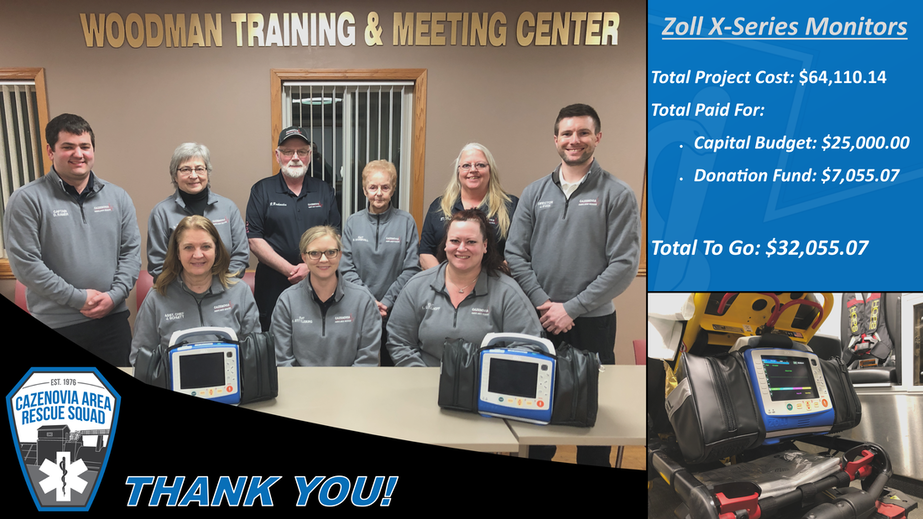Future needs
As a service who's line of work revolves around the direct care and well-being of patients, it is imperative that we remain current with not only training and best practices, but that we ensure our equipment is up-to-date to meet the needs of today's population.
As a group, we took a hard look at our service now, where we want to be, and the investments necessary to get there. When it comes to large capital expenditures, we analyze them in key areas: impact on patient care, benefit to the service & personnel, and the predicted frequency of use. For example, we considered a CPR device that would have a statistically marginal effect on patient outcome, would have a high benefit to staff, but would be utilized on fewer than 10% of our annual calls, that proposal was turned down.
As such, the crew had identified 3 key areas that we feel must be addressed in the next 5 years to ensure our mission of providing effective care to all who may need it. 1 goal has been accomplished, allowing us to work toward completion of the next 2.
The current areas of focus are:
As a group, we took a hard look at our service now, where we want to be, and the investments necessary to get there. When it comes to large capital expenditures, we analyze them in key areas: impact on patient care, benefit to the service & personnel, and the predicted frequency of use. For example, we considered a CPR device that would have a statistically marginal effect on patient outcome, would have a high benefit to staff, but would be utilized on fewer than 10% of our annual calls, that proposal was turned down.
As such, the crew had identified 3 key areas that we feel must be addressed in the next 5 years to ensure our mission of providing effective care to all who may need it. 1 goal has been accomplished, allowing us to work toward completion of the next 2.
The current areas of focus are:
- Paying Off Second Zoll Cardiac Monitor
- New Ambulance
Stryker powerload

Mission Accomplished
This investment was a focus on safety, for both the providers and the patient. This is a unit that we use on 100% of the patients we transport. We have witnessed firsthand the value of this equipment on our primary ambulance and now can experience the benefits of having it on our second ambulance as well.
We are incredibly grateful to our area community for their support in achieving this addition. Thanks to the generous contributions received, this purchase was completed with 100% donated funds, with no cost assessed to our district taxpayers.
This investment was a focus on safety, for both the providers and the patient. This is a unit that we use on 100% of the patients we transport. We have witnessed firsthand the value of this equipment on our primary ambulance and now can experience the benefits of having it on our second ambulance as well.
We are incredibly grateful to our area community for their support in achieving this addition. Thanks to the generous contributions received, this purchase was completed with 100% donated funds, with no cost assessed to our district taxpayers.
Zoll MOnitors

Halfway There
Our former Zoll E-Series cardiac monitors had reached their end-of-life and Zoll, nor the FDA, would no longer be supporting them. The writing was on the wall a few years ago and as such, we began planning for their replacement. Through frugal budget planning, we had allocated $25,000 in the regular capital budget toward the purchase of one monitor, with the second unit to be replaced the following year. This strategy was intended to lessen the strain on our annual budget and our donation fund. When ordering the first X-Series, we learned of an interest-free financing program through Zoll that would allow us to purchase both monitors at once, but only needing to pay for one upfront. When we first quoted these units out, they were $25,000 each, when the time arrived that we were in the position to order, they had increased to $32,000 each. Due to the fluctuating prices and uncertainty of the supply chain, we decided to lock in the price of the second unit and order both. We now have until January 31, 2023 to pay for the second monitor. While the allocation of funds in the capital budget has been planned for to pay toward the second unit, contributions made toward this goal will help to alleviate the burden on the budget and free up funds that will be saved and utilized for future equipment needs.
This equipment replacement was badly needed. We are very grateful for the forward progress of this project. Once paid for, the completion of this goal will fulfill our acute equipment needs, with the next planned capital project to begin in 4-5 years.
Our former Zoll E-Series cardiac monitors had reached their end-of-life and Zoll, nor the FDA, would no longer be supporting them. The writing was on the wall a few years ago and as such, we began planning for their replacement. Through frugal budget planning, we had allocated $25,000 in the regular capital budget toward the purchase of one monitor, with the second unit to be replaced the following year. This strategy was intended to lessen the strain on our annual budget and our donation fund. When ordering the first X-Series, we learned of an interest-free financing program through Zoll that would allow us to purchase both monitors at once, but only needing to pay for one upfront. When we first quoted these units out, they were $25,000 each, when the time arrived that we were in the position to order, they had increased to $32,000 each. Due to the fluctuating prices and uncertainty of the supply chain, we decided to lock in the price of the second unit and order both. We now have until January 31, 2023 to pay for the second monitor. While the allocation of funds in the capital budget has been planned for to pay toward the second unit, contributions made toward this goal will help to alleviate the burden on the budget and free up funds that will be saved and utilized for future equipment needs.
This equipment replacement was badly needed. We are very grateful for the forward progress of this project. Once paid for, the completion of this goal will fulfill our acute equipment needs, with the next planned capital project to begin in 4-5 years.
